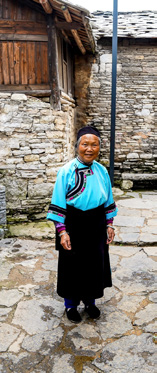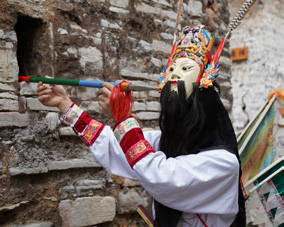 Sit back, relax and enjoy your seat in my time machine back to the 14th century during the Ming Dynasty (1368-1644); the armed forces of North China are entering Guizhou.
Sit back, relax and enjoy your seat in my time machine back to the 14th century during the Ming Dynasty (1368-1644); the armed forces of North China are entering Guizhou.
The local farmers are preparing for the invasion by amassing arrows and spears in their homes. Their arsenals are stacked meticulously with care under the small twelve inch holes in the stone walls of their homes. The holes make it possible to kill their enemies by shooting arrows and spears into the narrow alleyways.
In the center of the village is the high command tower to keep the farmers aware of the advancing armies. It was considered suicide to enter into the stone village.
As a part of their preparations, the Old Huns would first dance and sing to the rhythms of gongs and drums. The performers are wielding wood swords while singing ancient folk stories.
Their ritual is full of passion and pulsates with long, loud, booming voices. It is a sacred ceremony of the warriors of Guizhou, to entertain the gods and ask for triumph in battle.
 The dancers wear elaborate masks carved of wood, dress in cloth shoes and robes, with banners on their backs and weapons in their hands. The opera is known as the Living Fossil of Chinese Drama.
The dancers wear elaborate masks carved of wood, dress in cloth shoes and robes, with banners on their backs and weapons in their hands. The opera is known as the Living Fossil of Chinese Drama.
Today, people play the Di Opera for both exercising and entertainment. One can see and appreciate the energy expended by the dancers with both feet high off the ground. The masks of Di Opera are very horrific. Now they are ready for battle.
I was blessed with a private performance of the Ground Opera in the town square; traveling alone for photography with a private guide has its perks.
Nothing has changed in over 600 years, Guizhou still maintains their culture and customs which were lost in other providences in China.
Today, you will see the women wear blue and black dresses in the traditional way. Old men smoke tobacco in long pipes while lining up in front of the temple. In Anshun almost all of the homes are made of stone because of the abundance of rock in the mountains. Hence, the structures are still homes of village people.
Centuries later, it is astonishing to see the ornate carvings of support beams under the roofs. One can see that the cobblestone alleys and streets are barely worn after centuries and generations of use.
I felt I was actually back in this village generations ago. Notably, Guizhou was well acknowledged by the Chinese for thousands of years, but it was not until the Ming dynasty that it came under Chinese domination.
That said, it became a province. Guizhou’s economy is relatively meager as an undeveloped province. Fortunately, it is rich in aluminum, magnesium, mercury, other minerals, plus the gift of fertile farming land.
China is enchanting because, on the one hand, it has the most advanced modes of transportation and on the other still steeped in centuries-old customs.
For example, I traveled over one thousand miles in just over three hours and never left the ground. Their bullet trains are unbelievable. You can stand a quarter up on the window sill, and it won’t fall.
The minority village experiences are different from one hamlet to another. Now, returning to 2018, I checked into the Kempinski Hotel with a Rolls Royce and Mercedes dealership on the right side of the lobby.
What a world! www.RonMcGinty.com



